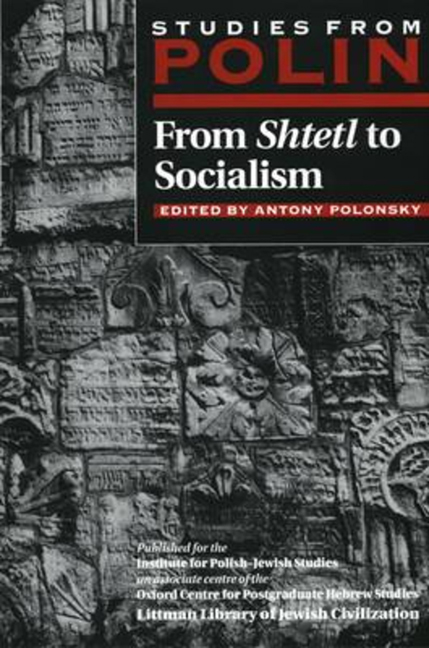Book contents
- Frontmatter
- Dedication
- Editors and Advisers
- Polin
- Polin: Studies in Polish Jewry
- Acknowledgements
- Contents
- List of Maps
- Introduction
- PART I PRE-PARTITION POLAND (to 1795)
- PART II THE NINETEENTH CENTURY
- PART III BETWEEN THE TWO WORLD WARS
- 15 Ethnic Diversity in Twentieth-Century Poland
- 16 Some Methodological Problems of the Study of Jewish History in Poland between the Two World Wars
- 17 Lucien Wolf and the Making of Poland: Paris, 1919
- 18 Aspects of Jewish Self-Government in Łódź, 1914-1939
- 19 The Image of the Shtetl in Polish Literature
- 20 The Polish Jewish Daily Press
- 21 From ‘Numerus Clausus’ to ‘Numerus Nullus’
- PART IV THE SECOND WORLD WAR
- PART V AFTER 1945
- Notes on Contributors
- Chronological Table
- Maps
- Glossary
- Index
18 - Aspects of Jewish Self-Government in Łódź, 1914-1939
from PART III - BETWEEN THE TWO WORLD WARS
- Frontmatter
- Dedication
- Editors and Advisers
- Polin
- Polin: Studies in Polish Jewry
- Acknowledgements
- Contents
- List of Maps
- Introduction
- PART I PRE-PARTITION POLAND (to 1795)
- PART II THE NINETEENTH CENTURY
- PART III BETWEEN THE TWO WORLD WARS
- 15 Ethnic Diversity in Twentieth-Century Poland
- 16 Some Methodological Problems of the Study of Jewish History in Poland between the Two World Wars
- 17 Lucien Wolf and the Making of Poland: Paris, 1919
- 18 Aspects of Jewish Self-Government in Łódź, 1914-1939
- 19 The Image of the Shtetl in Polish Literature
- 20 The Polish Jewish Daily Press
- 21 From ‘Numerus Clausus’ to ‘Numerus Nullus’
- PART IV THE SECOND WORLD WAR
- PART V AFTER 1945
- Notes on Contributors
- Chronological Table
- Maps
- Glossary
- Index
Summary
THE GENERAL PROBLEMS OF THE JEWISH KEHILLA IN ŁÓDŹ
Introduction
Poland's second largest city and major industrial centre was home to nearly a quarter million Jews comprising a third of the city's population by 1939. Łódź was second only to Warsaw among the more than 800 kehillot in Poland. Designated by government fiat in the 1820s to become a factory town, Łódź grew explosively as it attracted immigrants from near and far within the Tsarist empire. There are few works of rigorous scholarship on the history of the Jews in a city which was both a remarkable centre of proletarian movements in a predominantly agrarian country and at one and the same time a stronghold of Jewish tradition and secular Jewish socialism. There is also a dearth of studies of the local Jewish communities in interwar Poland, when their combined budgets amounted to 40 million ztoty or more annually.
There is in Poland, Israel and the USA a wealth of materials for the study of Łódź Jewry and its kehilla. Łódź was spared Warsaw's fate as a major battlefield, which deprived us of the records of the Ministry of Religions and Education's ‘Mosaic Department’, which had supervised the kehillot throughout the country, as well as the records of the Warsaw kehilla. In contrast, the archive of the Łódź kehilla was largely preserved, along with the records of local governmental agencies which had directly supervised and dealt with the kehilla. The extensive Yiddish and Polish press of both Łódź and Warsaw are an important resource, though partisan and inherently limited. The Łódź kehilla itself published and issued numerous reports, as well as a monograph on its first cemetery and the first periodical devoted to Jewish communal affairs in Poland. Unfortunately, few of the leaders of Łódź Jewry survived to publish memoirs or be interviewed by oral historians.
Concepts and Consensus
On the eve of Poland's rebirth there was a consensus among Polish Jewish groups that some form of self-governing communal organization was needed to unite and serve all Jews. The consensus extended to introduction of a democratic franchise, although the Orthodox opposed giving women the right to vote.
- Type
- Chapter
- Information
- From Shtetl to SocialismStudies from Polin, pp. 296 - 317Publisher: Liverpool University PressPrint publication year: 1993

